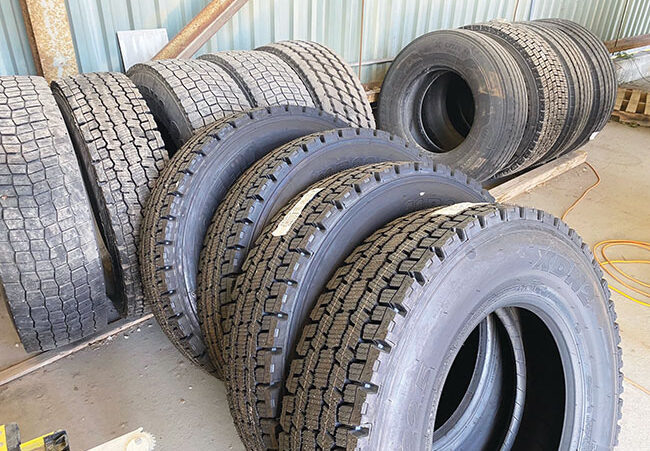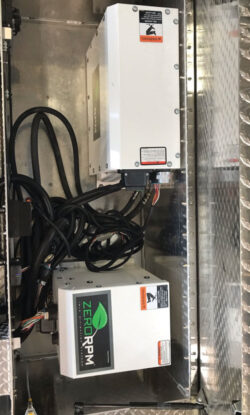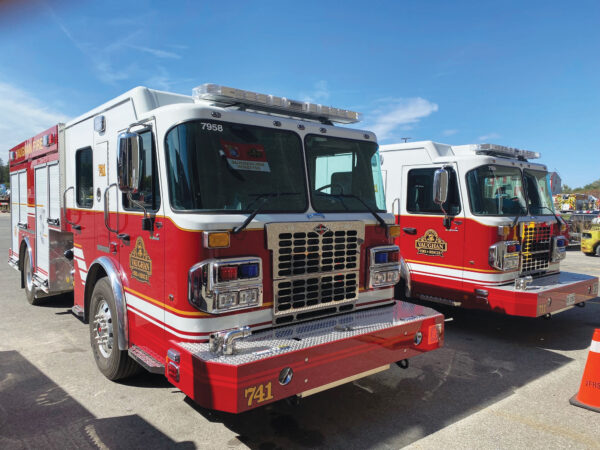
Features
Equipment
Tech Talk: The future of the fire truck
October 30, 2023
By Chris Dennis
 An inventory of spare tires makes sense when the new reality is a world of often unusually long wait times for
Photos by CHRIS DENNIS
An inventory of spare tires makes sense when the new reality is a world of often unusually long wait times for
Photos by CHRIS DENNIS The November edition of Fire Fighting in Canada always focusses on apparatus. I have always enjoyed this month; the articles in it sway more towards the apparatus, equipment and the service side of our business. I find, after being in the fire service for as long as I have been (which is a long time), that when it comes to building new trucks, there are always lots of players that want to get involved in the process. Some departments depend on committees. Some just the fire chief and their staff. Other departments put their faith in what is the latest and greatest or buy right off the shelf. Whether you’re full-time, composite or all volunteer, you, as the department, know what’s best for the communities you serve. This article is going to look at the future of building a truck, what that looks like when it comes to training, what parts might be like to source, and how the fire truck builders are going to be able to supply these parts with dynamics changing often.
Let’s say you want to buy a custom or commercial chassis fire truck. Pre-pandemic, a custom build took anywhere from six to 12 months based on the manufacturer. If it was a commercial chassis, such as a Freightliner, Pete or International on a custom apparatus it could have been even sooner. Stock or demo trucks were available in both configurations. If it was an aerial device you spec’d, these took a bit longer than an engine or pumper. If it was a rolling toolbox, squad, rescue or hazmat, timelines were about the same. If you are not building a new truck anytime soon, hey, you’re in luck. If you’re building now, you already know where I am going with this. To build an NFPA compliant custom truck today, we are seeing anywhere from 16 to 24 months. You have the capital and you build the spec. You order the truck in 2023 and you get it in 2025. What happened? Where is the disconnect? How did all this change from 2019 to 2023? I have not looked into stats or data to answer this. I don’t have to. Ask and you will hear why. Since covid, the supply chain has gone from lots of raw materials and lots of in-stock parts to bolt on, and lots of labour available, to the exact opposite.
The car companies realized in year two of covid that manufacturing came to a standstill when people were not coming to work. Parts and raw materials to build vehicles were no longer readily available. To have mass amounts of inventory sitting on dealership lots and in vacant fields and parking lots across the country was no longer the case.
Now, in 2023, it seems the car builders have realized they no longer have to build up big inventory. They will wait for the vehicle to be ordered. The customer waits and this saves the builder time and money. If the customer is not happy with the wait, they move on to next car dealer. Personally, we unfortunately lost a 2019 Ford Explorer to an accident (only property damage, no people hurt). We ordered a replacement, and it came in 2023. Good news is that it is a 2023 model. Bad news is that we had to accept what they built us or the price would change dramatically. The blessing is we can make it what we ordered. The price increase was over $15,000. Take it or leave it is what we got.
If you had a new vehicle on your lot and another dealer had a customer wanting the vehicle, there was no such thing as a dealer helping another out. This vehicle was being sold for full list price because the customer had to have it — to lose it to another dealer was not happening. Dealerships got creative making purchasing deals with customers. I heard dealers could not order vehicles and make them demos as it cost the dealer too much to bring it in and that was because there was nothing being built in mass numbers. If this is true, I am sure if I was the new vehicle dealer, a plan could be hatched. Example: I want a pick-up truck. What I want is six months away. I settle for what they have or can get right away. However, I also order the one I want. When it comes in, the dealer takes the less desirable one at full face value and sells me the one I really wanted at the price set six months ago. They get a vehicle back with road mileage on it. They sell it at more than market value as people need it and I get the vehicle I wanted at the price agreed (even though it’s inflated).

Systems like this eco idle reduction system are part of the new wave of technology that needs extra consideration in terms of service needs.
Fire truck builders are not the same. Fire trucks have always been built on demand. The cookie-cutter fire truck could be built but it would have to be done through a selling dealer. The selling dealer would have to then be able to bankroll the build and hope they could sell it once built. In discussion with a few fire truck dealers, what I’m hearing is that they can’t even have a cookie-cutter truck built as the demand for trucks is so high, and the lead times for materials and parts is so far out, that the department spec built truck will be done first.
The next thing to take into consideration is the dollar value of this truck. Purchasing agreements are a must. The bid request goes out, the build is awarded to a selling dealer, and the price is locked in. Please be sure you make sure the price agreed on stays that way. The market, as we know, changes daily, weekly, monthly. Clothing, food and utilities seem almost impossible to budget for nowadays. The selling dealer will have to inflate today’s truck cost to offset whatever the cost in a few years will look like, or write in the proposal a price increase as time goes on. It’s crystal ball stuff. Who will know what is going to happen price-wise? Well, we know it won’t go down. The automotive sector is worse. Remember what I said earlier? Order a truck today and get it two years from now — not two months, not 12 months, but about two years. There is no way, unless a written contract is broken, will they stick to price given. If they do, I am sure the price was inflated to begin with just knowing that when it is done the market will have caught up to what it’s worth.
If you can secure a long-term purchasing agreement with a specific builder for a certain number of vehicles over a predetermined timeline, the bottom line and fine print is important. I am sure legal departments within the municipalities will, and are, busy protecting the financial side of the business. A custom or commercial built pumper purchased in 2006 was $250,000 to $450,000. The same truck today is $1 million.
I wrote an article in early 2023 for Fire Fighting in Canada about the electric fire truck. I am excited to see how electric fire trucks will work out, but I think we will wait for “the other guy” first. Like the EV car market, the evolution of this design changes like we change our outfits. The battery design, and the truck design, the electric and solution systems being installed, all happened so fast that the engineers are seeing they can do better. The trucks we saw late last year and this year in the EV market have already changed. Once you get it, it may have already been re-designed. As any mechanic will tell you, when you ask this question: “If I buy or do this now, will it change or break again later on?” — the answer is — “I wish I knew the answer to that. My crystal ball fell off the table long ago.” What we do know for certain, is that the future of fire truck building is changing.

Two new trucks equipped with green technology at Vaughan Fire.
The future
The new rig has arrived! It’s exciting, it’s new, and it replaces “old yeller” who was over 20-years-old. Traditions bring us all together where we roll out the old and push in the new. I want the new truck to be operational and ready for the business we provide. That’s why we replaced it — to be dependable. The last thing we need is to take it out of service for a repair at the selling dealer or repair shop, which may also now be an issue. Repair facilities are often understaffed, over-booked and getting parts is a whole new ball game. The wait times for parts we have seen run out to six weeks because they are not available.
My suggestion here is this. If you purchase a non-spec built truck (let’s call it a demo), then you get what you get. If you spec-build a truck, do your homework. Know what every part is that is going on the truck. Have an idea if the part or piece is going to be available, or if it is a one-off thing you are picking because it’s cool. Or, if the truck is a pedigree and all the truck pieces are outsourced and made specific for that builder, ask those questions. For example, take a simple thing like a windshield. If it’s a commercial truck, the odds are the OEM, and for sure aftermarket, should be able to secure one quickly. If it’s a custom truck with a window opening proprietary to the manufacturer, that means they have an outside company building this glass for them. They depend on that outside source to be able to supply this one-off glass when building, and again when needed four years from now for a crack, chip or delamination. Pre-covid, this was not-so-much an issue. Hopefully, when you need it, the fire truck builder has stock, or the outside company is still in business and you can order and wait for one. Ask this simple question of anything. Are the parts used readily available at any outside source? Granted, some parts can only come from the builder (steering and suspension). Does the builder use vehicle specific parts or are they off-the-shelf available parts? The surprise should not be when the truck is down. If the parts could be an issue later, then you may want to put into the spec extra parts to be delivered when the truck is done. This drives up the cost again.
The issue with parts is worldwide. It includes everything that has a part to be purchased for repairs. Recently we needed eight drive tires. I spec a specific make and model of Michelin. In our case, this is because they work well for us. We are also part of a national fleet purchasing program. The size is common even for over the road trucks and the model as well (not a unicorn, as we say). There was nothing in captivity. I looked into Goodyear as well as Bridgestone and Toyo. My concerns are always size tread design for the tire position and load range. I was surprised, but because the size is popular, the tire people were out of stock. No raw materials. So, my simple request became a challenge. I was able to work this out and get the truck on the road, saying that this is what I do for our department. Your department may not have a dedicated apparatus division and you may depend solely on your fleet or outside repair facility. You believe what they tell you, that’s why you trust and deal with them. However, sometimes you may have to go at it harder to find what they say is not available.
This holds true for other wear and tear items. I would suggest calling your local parts dealer and checking to see if simple things like brake parts, steering parts, suspension parts, lighting, door handles, seat belts and especially air bags are available. When you get your answer, you can make a calculated decision. Do I do what I have never done before and keep stock on wear and tear items because they have no stock now, or wait and hope they do when the time comes? Vaughan Fire is, for the most part, a single source department. A lot of one thing fits many trucks so we stock one or two of these things. However, we also have a division dedicated to fire truck repair — your FD may not. If not, call your local truck repair shop to see if they stock pads, rotors, drums, shoes, and spring kits, for example, for your trucks. If not, ask them to check availability. If limited, have them stock it for when the time comes. It will. I now stock tires. Something I never did before. We have always been just-in-time. I wrote a report to the deputy and fire chief suggesting more money be put in the budget for stocking more parts. Tires alone can be upwards of $10,000 for eight drive tires or $2,000 to $4,000 for super singles. Your repair budget will need to be increased so the rigs are not parked. We are coming into cold weather. Out of service waiting for parts may mean they sit outside. This means more cost to winterize pumps, etc., until parts come in. You need to be more proactive with parts so you are not caught by surprise.
Last item with trucks of today is how quickly technology is changing. I belong to a Facebook group of fire truck repair technicians and EVTs across Canada and the U.S. called F.A.T. Fire apparatus technicians community, this great group of unsung men and women in this great fire service that keep these rigs on the road. It amazes me what level of service each department does. It’s a great source for troubleshooting and helping other technicians. One item I see more often now than before is the level of electronic questions being asked. If you have a say in who fixes your trucks, be sure they are up-to-date with the latest technology and solutions in your trucks. We recently took delivery of three new engines. These engines are equipped with a system called ECO IDLE-TEC. This is almost a hybrid of sorts. It’s a lithium-ion battery mounted on top about 24-inches in size with an inverter battery charger. This unit, once programmed is not only the 110v power source or generator, it also will shut the diesel engine down to control emissions and take over the entire electrical system as if the diesel engine was still running. This saves on fuel and greenhouse gases. This system will not shut the truck engine down if in regen pump gear or aerial PTO function. Operational training is needed as well.
Take care, be safe, and if you have any question email me. Remember my friends be safe, stay healthy and rubber side down!
Chris Dennis is the chief mechanical officer for Vaughan Fire and Rescue Service in Ontario. He can be reached at Chris.Dennis@vaughan.ca.
Print this page